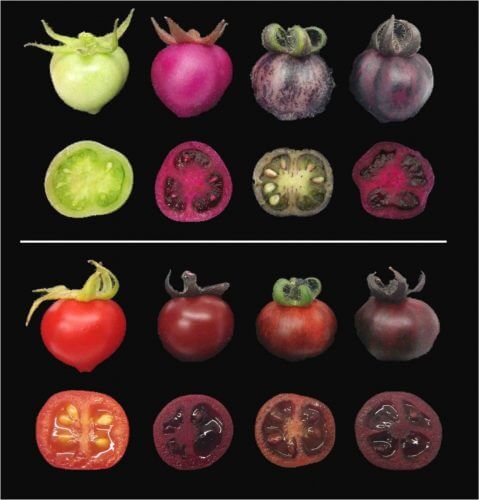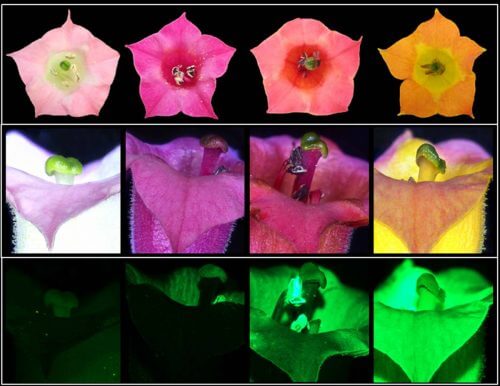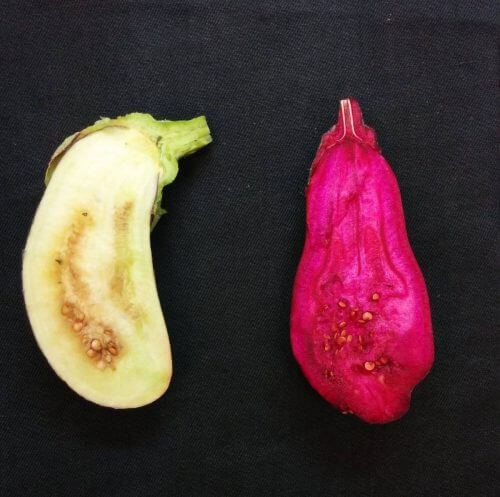Researchers from the Weizmann Institute succeeded in making edible plants produce beet pigments - thus improving their nutritional values and durability

The celebration of colors in the plant kingdom is not only a feast for the eyes. Colored pigments attract pollinating insects to the flowers, protect the plants from disease, and increase their survival in many other ways. These pigments are also of great value to humans: they are beneficial to health, and are used in the food and pharmaceutical industries.
New research at the Weizmann Institute, which Recently published in the scientific journal Proceedings of the National Academy of Sciences of the USA (PNAS), paves the way for the development of applications based on betalains - vegetable pigments in red-purple and yellow colors.
The betalains are created in nature by a few edible plants, chief among them beets, the fruits of cacti (including the fruit of the common saber, "severes"), as well as certain flowers, such as bougainvillea. The betalains are relatively rare compared to other groups of plant pigments, and until now very little was known about how they are formed.
Prof. Assaf Aharoni from the Department of Plant and Environmental Sciences, and Dr. Guy Polturk, then a research student, along with other group members, used in their research two plants that produce betalains: red beet (Beta vulgaris), and a plant known as the "Queen of the Night" jalapa mirabilis). Using advanced genomic technologies, they were able to discover a new gene involved in the production of betalains, and found which biochemical reactions convert the amino acid tyrosine into betalains in the plant.

In order to test their findings, the scientists developed genetically modified yeast that produces betalains. Then they approached the ultimate challenge: to make edible plants that do not produce betalains naturally, produce these pigments. Success shone in iridescent colors: the scientists produced red-purple potatoes, tomatoes and eggplants. Furthermore, they were able to control precisely in which tissues of the plant the betalains were produced. Thus, for example, the pigment colored only the fruit of the tomato, and not the stem or the leaves.
Using this approach, the scientists caused white petunias to grow light purple flowers, and tobacco plants to grow flowers of different colors - from yellow to orange-pink. They achieved the desired shade each time by causing the pigment-related genes to be expressed in different combinations. These findings may help to develop ornamental plants in unconventional colors, upon demand.
The scientists discovered that the betalains protect the plant from the "gray mold" fungus, which annually causes billions of dollars in damage to global agriculture; In the transgenic plants, the resistance to this mold increased by 90%

However, apart from the change in color, the creation of betalains also had health benefits: the antioxidant activity in the tissue of the engineered tomatoes was 60% higher compared to normal tomatoes. "Thanks to these findings," says Prof. Aharoni, "it will be possible in the future to cause edible plants to produce betalains, in order to increase their nutritional value." Furthermore, the scientists discovered that the betalains protect the plant from the "gray mold" fungus (Botrytis cinerea), which annually causes billions of dollars in damage to global agriculture; In the transgenic plants, the resistance to this mold increased by 90%.
During the research - which was partnered by Noam Grossman, Dr. Yonghui Dong, Margarita Pliner and Dr. Ilana Rogchev from the Department of Plant and Environmental Sciences, and Dr. Maggie Levy, Dr. David Leh Corsia and Adi Nodel from the Hebrew University of Jerusalem - the scientists created Betaine versions that do not exist in nature. Dr. Polturk explains the significance of the finding: "It may turn out that some of the new pigments are more stable than the natural betalains. This can be of great benefit to the food industry, which makes extensive use of betalains as natural food colors. So, for example, red strawberry yogurt is colored using betalains derived from beets."
Besides the change in color, the creation of the betalains also had health benefits: the antioxidant activity in the tissue of the engineered tomatoes was 60% higher compared to normal tomatoes

The findings can also be used by the pharmaceutical industry. The first link in the production chain of betalains is the conversion of tyrosine into a chemical substance called L-DOPA. Besides being a drug in itself, this substance serves as a basis for producing other drugs - especially opiate pain relievers such as morphine and codeine. Therefore, it may be possible to engineer plants and bacteria so that they convert tyrosine into L-DOPA - thus becoming a source of this important substance.

22 תגובות
my father
Genetically modified food is not grown in Israel. Neither in Europe. It is possible that they import genetically modified cows from the USA - you probably know better than I do.
Like I said, I don't think anyone here has tasted genetically modified fruit.
And if you're already talking about miracles in the flood of nonsense on the subject, then get some more talk:
In the future, all food will be infected with genetic engineering.
Because genetic engineering is a "contagious disease".
Some of the genetically modified genes are transferred from a non-transgenic plant through pollination, so in the future it may not be possible to obtain genetically modified food at all.
Continuation: On the website of the Ministry of Health it is written that in 2006 they started thinking about a regulation like there is in Europe that requires marking such products, but as far as I know there is no such regulation or law in Israel and if there is it is not implemented and there is no ability to implement it.
Those who want to avoid genetic engineering or pesticide residues in food should purchase products that are marked as an "organic" product and there is also a "no genetic engineering" marking.
The manufacturers who mark the products with such a marking are subject to the supervision of bodies that check them, and they are expected to face lawsuits if they do not meet the requirements, so it is likely that they are indeed careful about this, although of course these products are more expensive.
for miracles
As far as you know, there is no such law in Israel, we have been thinking and discussing such a regulation for several years, but for now it is completely broken.
In Europe there is a law that forces such products to be marked. (The sad situation is described on the website of the Ministry of Health - https://www.health.gov.il/UnitsOffice/HD/PH/FCS/NovelFood/Pages/EngFood.aspx)
For your information, most of the agricultural products that the food producers in Israel import (various grains such as corn, wheat, rice, as well as concentrates and tomato paste, oil, flour... and more) the food factories purchase in international tenders in large quantities, it arrives in bulk in ships, containers, barrels, and large containers, passing A very minimal number of mandatory tests, (the sample is extremely poor and not even statistically representative, in one company I once visited they sampled one cup to confirm the shipment of an entire ship's worth of corn) .
There is no ability to test and there is no restriction on genetic engineering on the use of one or another pesticide, etc.
my father
My point is simple - there is no genetically modified food in Israel. It's against the law.
Just an interesting fact that contradicts all the nonsense being said here.
For miracles - since there is a lot of engineered agricultural produce, and most of the agricultural produce that has been developed recently, either through genetic engineering or through artificial selection (tomatoes, cucumbers, peaches, and so on) is beautiful to look at, but lacks taste and smell, so he is right in his concerns, even if he has not actually eaten the This particular tomato is the color of beets.
Not Ben Ner
I don't mix
There is a corporation that is engaged in the production of seeds and also pesticides.
They produce pesticides against weeds and at the same time with the help of genetic engineering plants that are resistant to the herbicides, so that the farmer can grow edible plants and spray them with plant pesticides that kill all other plants and leave the desired plants alive, and this saves the farmer the need to uproot weeds.
The problem is that they later discovered that these chemicals are carcinogenic.
This is something that happened with the glyphosate.
Another patent is that potatoes or corn or tomatoes, etc. are "resistant to pests", the resistance is acquired by inserting a gene found in other plants that produce a poison from the nicotine family inside the plant. (For example, you take the gene that produces nicotine in tobacco and plant it in tomato or corn)
The problem is that the amount of nicotine in the transgenic plant is not controlled and an edible plant is too toxic.
my father
Are you trying to relate to what I said? I asked if Yosef, or anyone else here, tasted genetically modified food?
Why do you refer to things I didn't say? And in such a flood of ropes??
To my father
You are confusing the concept of "extermination" with the concept of "genetic engineering". In fact, genetically modified seeds require, in principle, less and less spraying of pesticides. Although you gave an example that demonstrates the opposite of my apparent words, it seems to me that this is an unusual example. In principle, the advantages of genetic engineering in the improvement of varieties are so many that, in fact, today, all agricultural produce is genetically modified, either with older technologies of "improvement from generation to generation" or with newer technologies of genetic micromanipulation.
By the way: the same also applies to livestock products such as: meat, chicken. milk and eggs.
Miracles
For your information, a great many of the agricultural products that are on the shelves today are genetically engineered, especially grains.
Genetic engineering is already causing a lot of damage to farmers in the third world who rely on heirloom seeds.
Three problems that this genetic engineering creates (like this from memory):
1. Plants are resistant to pests because a gene has been inserted into them that causes them to excrete natural pesticides such as nicotine in a significant and uncontrollable excess (and who wants to eat a potato with nicotine anyway?).
2. Infertile plants on purpose so that the manufacturer has control over the seeds and can only buy from him, the sterility feature also passes through pollination to plants in the wild and destroys their varieties (this is related to what I wrote earlier about heirloom seeds).
3. The manufacturer Monesto produces seeds with resistance to the herbicides it produces (glyphosate), and this causes farmers to spray the herbicide on the plants they eat, they are absorbed by the plants we eat, recently it was discovered that glyphosate is carcinogenic.
Link: http://www.zavit.org.il/קוטל-עשבים-מסוכן-לאנשים
And there's more...
Yosef
The change in taste you supposedly feel has nothing to do with genetic engineering. On the contrary - with genetic engineering it is possible to improve crops without harming the taste. I don't even think you've ever tasted genetically modified fruit.
I meant that some of us see a woman as an external package and as a result some women also see themselves as an external package
And don't look at the content. The packaging is also important to be reasonably attractive, and especially the content.
The GM food has a plastic taste. To the orange, to the giant red plums, to the tomato. There is none of the juiciness that I used to remember. It is not important that the peach has a good taste, it is important that it lasts a long time and is beautiful. Like women in the eyes of some of us - and this was said through sarcasm.
Doron
Don't you think there should also be labeling of products that came from genetic improvement? Like for example...everything we eat?
That is why labeling of products containing GMO genetically modified ingredients is required
Henry
I buy wonderful mangoes at the supermarket. super replacement…..
I ate a mango yesterday, a shocking experience.
It has nothing to do with the original taste of the mango from 30 years ago.
Although the fruit is beautiful and feels just the right amount of ripeness, it is bitter and tasteless.
It's been years since I had the chance to taste a real sweet mango with the real taste of a mango.
The only solution is to grow original varieties in the yard with organic fertilization. This is for those who have a yard of course, the rest avoid fruits, eat spoiled plastic genetics and think they are contributing to their bodies in this.
The responses of all the respondents before (4 in number) had the same content (more or less) which is mainly; "Genetic Hindus (shigenut) reduce the taste and quality of the fruit".
These are of course nonsense. The shignot improves the fruit in many parameters, (as explained in this article and in many other articles) such as: color, concentration of anti-oxidants, fruit size and shape, shelf life and fruiting season throughout almost the whole year.
Without shignot humanity will not be able to meet the nutritional needs of the exponentially growing world population. In Israel, the problem is that the agricultural areas are getting smaller and smaller and there is an increasing need to get more and more quality crops with high nutritional values, per agricultural dunam, in order to satisfy the market consumption.
In the medium and long term, only the Shignot can provide the solution to these challenges.
How long will time and resources continue to be wasted on producing worthless botanical monsters, while humanity's main problem is waiting to be solved? I mean, of course, THC-producing lettuce.
The genetic change (shagnot-leschagant) may improve the content of the food, but it lacks taste and smell and is therefore misleading only for pigs who eat everything, therefore it is a great shame that academics with no knowledge of nutrition engage in shagnot of food, because humans stop eating it. Brave enough academics already! Please give us back the original, tasty and good food even at a high price.
How about tastier. Some tomatoes have a plastic taste.
You don't need beet-colored tomatoes that are tasteless and odorless and with genetic engineering!
And "resistance to pests and diseases" it just means that the plant secretes more toxic chemicals like nicotine and they give it this resistance.
Maybe instead of this nonsense you will give us back the tomatoes of old with the smell of a tomato and the taste of a tomato.
May the beet remain a beet, and may the tomato return to being a tomato.
Stop messing with our food with genetic engineering! Leave genetic engineering to the pharmaceutical industry alone.